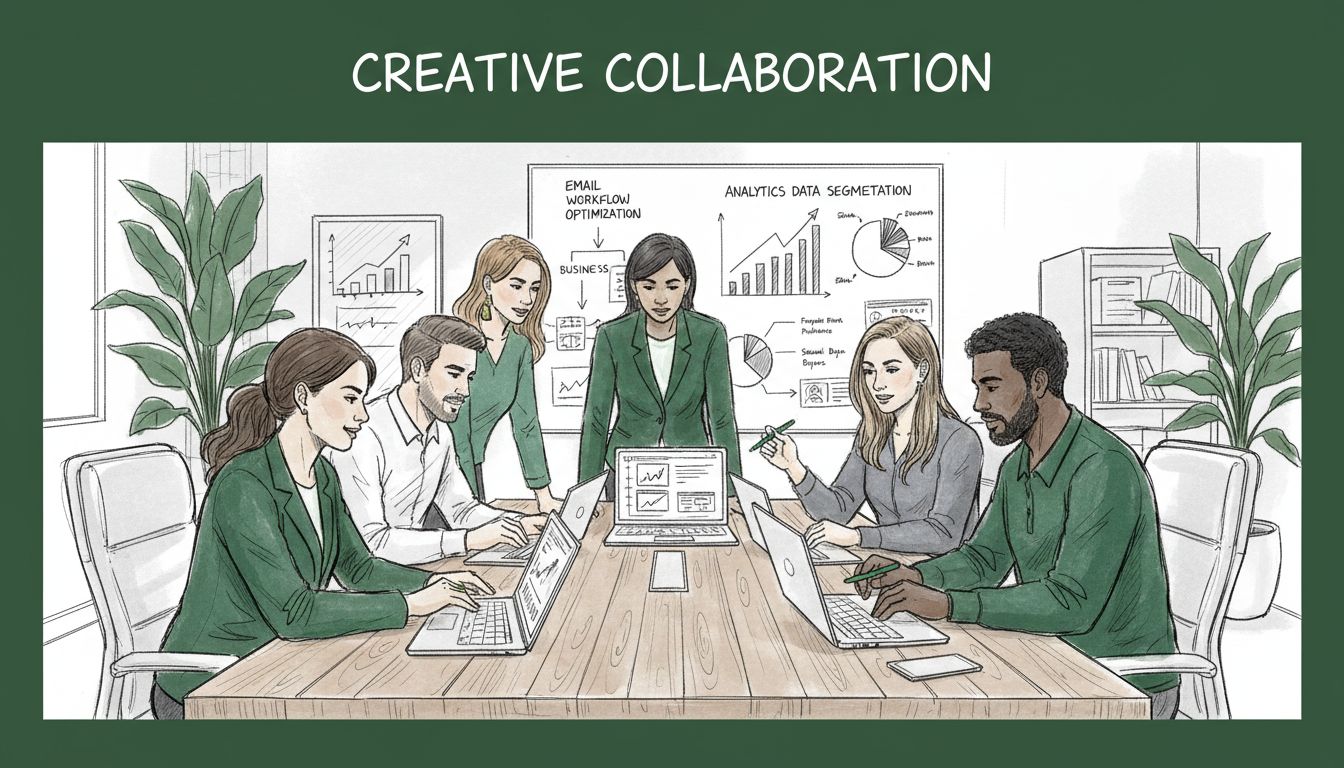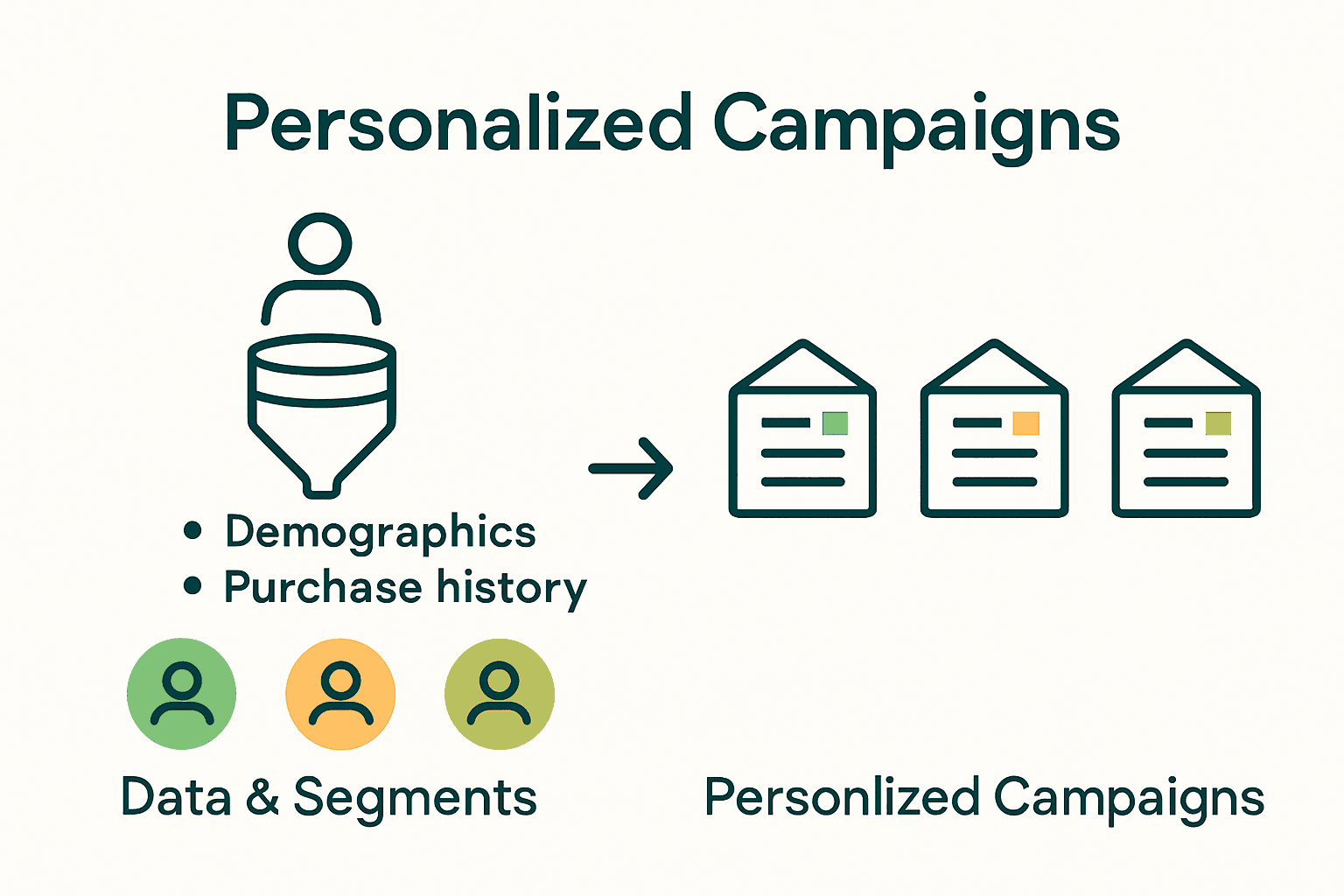Personalized Email Strategy Guide For E-Commerce Success

Over 60 percent of american businesses miss out on the full potential of personalized email marketing. In a crowded inbox, only messages crafted for real people stand out and drive results. Learning how to assess your data, segment your audience, and personalize emails can mean the difference between being ignored or building ongoing loyalty. This guide gives you a roadmap to build smarter email strategies that keep your brand top of mind.
Table of Contents
- Step 1: Assess Customer Data And Audience Segments
- Step 2: Develop Segmented Email Campaign Frameworks
- Step 3: Craft Dynamic Personalized Email Content
- Step 4: Automate Lifecycle Flows And Triggers
- Step 5: Analyze Performance And Optimize Campaigns
Quick Summary
| Main Insight | Description |
|---|---|
| 1. Assess Customer Data and Segments | Analyze comprehensive customer data for better segmentation, targeting campaigns to improve engagement. |
| 2. Develop Customized Email Campaigns | Create specific email frameworks for different customer segments, enhancing personalized communication. |
| 3. Use Dynamic Content in Emails | Incorporate behavioral data to create relevant and tailored email experiences for customers. |
| 4. Automate Lifecycle Email Processes | Set up automated triggers to anticipate customer needs and respond with timely, relevant communications. |
| 5. Regularly Analyze and Optimize Campaigns | Continuously track performance metrics and refine strategies for sustained improvement in engagement rates. |
Step 1: Assess Customer Data and Audience Segments
Customer data assessment is your strategic roadmap for personalized email marketing success. By understanding your audience segments, you can craft targeted campaigns that significantly improve engagement and conversion rates.
According to research from MDPI, advanced customer segmentation techniques like K-Means clustering can help marketers categorize customers based on purchase behavior. This approach allows you to focus on high-profit segments and tailor your messaging precisely. Start by collecting comprehensive data points including:
- Purchase history
- Browsing behavior
- Demographic information
- Engagement levels with previous email campaigns
Analyze these data points to create meaningful customer segments that go beyond basic demographics. For instance, you might identify segments like “frequent purchasers,” “seasonal buyers,” or “brand loyalists.” Each segment requires a unique email strategy that speaks directly to their specific needs and preferences.
The key is granular segmentation.
 Dont treat your entire customer base as a monolithic group. A skincare enthusiast and a bulk purchasing professional will respond to dramatically different email approaches. By developing nuanced segments, you create personalized experiences that feel individually crafted.
Dont treat your entire customer base as a monolithic group. A skincare enthusiast and a bulk purchasing professional will respond to dramatically different email approaches. By developing nuanced segments, you create personalized experiences that feel individually crafted.
Ready to transform your data into actionable marketing insights? The next step involves developing targeted email strategies for each carefully defined segment.
Step 2: Develop Segmented Email Campaign Frameworks
Building effective email campaign frameworks requires strategic planning and precise targeting. By developing nuanced segmentation approaches, you can create highly personalized communication strategies that resonate with each customer group.
Research from ResearchGate demonstrates the powerful impact of behavioral segmentation in email marketing. By analyzing user actions like browsing behavior and past purchases, you can craft messaging that speaks directly to specific customer needs.
To develop robust campaign frameworks, consider these strategic approaches:
- Create distinct email flows for different customer lifecycle stages
- Design unique content and offers for each identified segment
- Map out triggers and automation based on specific customer behaviors
- Develop personalized subject lines and messaging that align with segment characteristics
According to ArXiv, advanced multi-task learning algorithms can further refine your segmentation strategy. This means moving beyond basic demographic splits to create dynamic, responsive email campaigns that adapt to individual customer interactions.
Your goal is building flexible frameworks that feel individually tailored. A welcome series for a first-time buyer will look dramatically different from a re-engagement campaign targeting lapsed customers. Precision is key.

With your segmented campaign frameworks in place, you are now prepared to implement sophisticated email marketing strategies that drive meaningful customer engagement.
Step 3: Craft Dynamic Personalized Email Content
Dynamic personalized email content transforms generic marketing messages into powerful customer engagement tools. Your goal is creating emails that feel like one-on-one conversations, not mass communications.
Research from ResearchGate highlights the critical importance of understanding target audiences through advanced data analytics. This means going beyond basic personalization like inserting a first name and diving deep into creating truly relevant content experiences.
To craft compelling personalized content, consider these strategic approaches:
- Use behavioral data to trigger contextually relevant messaging
- Match email tone and language to specific customer segments
- Create dynamic content blocks that change based on user preferences
- Incorporate product recommendations aligned with individual purchase history
According to MDPI, advanced segmentation algorithms can help refine your content strategy by uncovering nuanced customer characteristics. This means your emails can become increasingly sophisticated and targeted over time.
The most effective personalized emails feel like they were crafted specifically for one individual. A fitness enthusiast should receive different content than a budget conscious shopper. Your messaging should reflect not just who they are, but what they care about right now.
With your dynamic content strategy in place, you are ready to implement email campaigns that truly connect with your audience on a personal level.
Step 4: Automate Lifecycle Flows and Triggers
Automating lifecycle flows and triggers transforms your email marketing from reactive messaging to predictive customer engagement. Your goal is creating intelligent email systems that intuitively understand and respond to individual customer journeys.
Research from ArXiv demonstrates how machine learning techniques can revolutionize customer segmentation by dynamically evaluating customer interactions. This means developing automated email flows that adapt in real time based on specific user behaviors and preferences.
Key strategies for effective lifecycle automation include:
- Map out distinct customer journey stages
- Create trigger points based on specific customer actions
- Design responsive email sequences that adapt to user engagement
- Implement time sensitive and behavior driven communications
According to ArXiv, advanced probabilistic frameworks can help model complex customer interactions. By understanding nuanced customer similarities, you can create more sophisticated automated triggers that feel personal and timely.
Think of lifecycle automation like a responsive conversation. A new subscriber receives different emails than a long-time customer who hasnt purchased recently. Your automated flows should feel like an intelligent assistant anticipating customer needs before they even realize them.
With your automated lifecycle flows in place, you are now equipped to deliver precisely timed and deeply personalized email experiences that boost engagement and drive conversions.
Step 5: Analyze Performance and Optimize Campaigns
Performance analysis is the critical heartbeat of successful email marketing strategies. Your goal is transforming raw data into actionable insights that continuously improve your campaign effectiveness.
Research from ArXiv proposes advanced model-based projection techniques for understanding customer preferences. This means moving beyond surface level metrics to develop sophisticated analytical approaches that reveal deeper engagement patterns.
Key performance optimization strategies include:
- Track critical email marketing metrics
- Compare performance across different customer segments
- Identify high performing content and messaging approaches
- Conduct systematic A/B testing for continuous improvement
According to MDPI, advanced algorithmic approaches like improved clustering techniques can help marketers develop more precise segmentation strategies. By understanding nuanced customer group characteristics, you can create more targeted and effective campaigns.
Successful optimization is an ongoing process. Look beyond basic open and click rates. Analyze deeper metrics like conversion value, repeat purchase rates, and customer lifetime value. Your data should tell a story about customer behavior and engagement.
With a robust performance analysis framework in place, you are now equipped to create email marketing campaigns that continuously adapt and improve based on real world insights.
Unlock the Power of Personalized Email Marketing for Your E-Commerce Brand
The challenge many e-commerce businesses face is transforming customer data into dynamic, personalized email campaigns that truly engage and convert. This article highlights the importance of granular segmentation, automated lifecycle flows, and data-driven content that resonates on an individual level. If you struggle with developing tailored strategies that increase repeat purchases and build lasting customer relationships, you are not alone.
The Email Marketers specializes in solving these exact problems. We go beyond generic email blasts by crafting AI-driven segmentation frameworks and automated flows designed specifically for your audience. Our team excels at turning complex customer insights into high-converting, personalized campaigns that boost lifetime value. Ready to stop guessing and start connecting? Discover how our strategic retention marketing services can transform your email approach today.
Explore how we deliver measurable ROI with precision by visiting The Email Marketers. Learn more about our expertise in building automated email flows that predict customer needs and developing powerful segmentation strategies that engage every unique audience segment. Don’t wait until your competitors outpace you. Take control of your retention marketing strategy now and watch your e-commerce success soar.
Frequently Asked Questions
What are the first steps to assess customer data for personalized email marketing?
Start by collecting comprehensive data points like purchase history, browsing behavior, demographic information, and previous email engagement levels. Analyze these aspects to create specific customer segments to better tailor your campaigns.
How do I develop segmented email campaign frameworks?
To create segmented email frameworks, outline distinct email flows for different customer lifecycle stages and design unique content for each segment. Implement this strategy to ensure messages resonate based on customer behaviors, leading to higher engagement rates.
What strategies can I use to craft dynamic personalized email content?
Utilize behavioral data to trigger relevant messaging and match the language tone to specific customer segments. For example, consider incorporating dynamic content blocks that change based on user preferences to enhance personalization.
How can I automate lifecycle flows and triggers in my email campaigns?
Map out distinct stages of the customer journey and create triggers based on specific actions taken by customers. Implement responsive email sequences to adapt communication based on user engagement and enhance the customer experience.
What metrics should I track for analyzing email campaign performance?
Focus on critical metrics such as open rates, click rates, and conversion value. Conduct systematic A/B testing to discover which content performs best and optimize campaigns for improved results over time.
How often should I optimize my email marketing campaigns based on performance data?
Continuously analyze performance data and make adjustments every 30-60 days to stay responsive to customer behavior. Systematic optimization helps maintain campaign effectiveness and boosts overall engagement.
.png)








